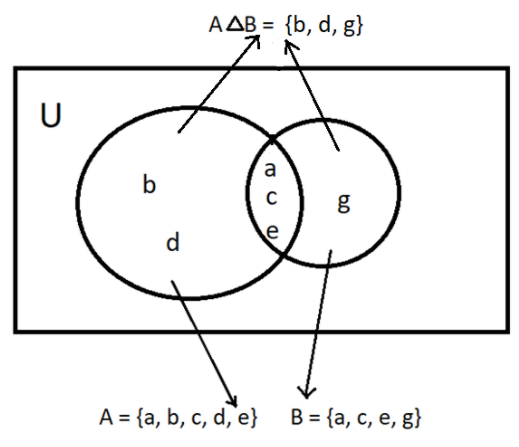
Find \[A\Delta B\] and draw Venn diagram when:
\[A = \left\{ {a,b,c,d,e} \right\}\] and \[B = \left\{ {a,c,e,g} \right\}\]
Answer
579.3k+ views
Hint: In this particular question find the elements that are not common to the set A and B because \[A\Delta B\] is a set of all elements which are not in both sets (i.e. uncommon elements).
Complete step-by-step solution:
Now as we know that Venn’s diagram is a diagram representing mathematical or logical sets pictorially as circles or closed curves within an enclosing rectangle (the universal set), and common elements of the set are represented by intersections of the circle or closed curves.
So, now let us first draw the Venn’s diagram for the set A and B.

As we can see from the above Venn’s diagram that the element {b, d, g} does not belong to both the sets or in other words each of the elements of set {b, d, g} either belong to set A or set B.
So, \[A\Delta B = \left\{ {b,d,g} \right\}\]
Because \[A\Delta B\] is the set of all elements that are not present in all sets.
Hence, \[A\Delta B = \left\{ {b,d,g} \right\}\].
Note: Whenever we face such types of questions the key concept recall is that if there are two sets X and Y then \[X\Delta Y\] will be set having elements that are not present in both the sets X and Y. So, we can directly find the value of \[X\Delta Y\] by applying the formula that is \[X\Delta Y = \left( {X \cup Y} \right) - \left( {X \cap Y} \right)\], where \[\left( {X \cup Y} \right)\] will be the set of all elements of set X and Y. While \[\left( {X \cap Y} \right)\] will be the set of common elements of set X and Y. This will be the easiest and efficient way to find the solution to the problem if the Venn’s diagram is not asked to draw.
Complete step-by-step solution:
Now as we know that Venn’s diagram is a diagram representing mathematical or logical sets pictorially as circles or closed curves within an enclosing rectangle (the universal set), and common elements of the set are represented by intersections of the circle or closed curves.
So, now let us first draw the Venn’s diagram for the set A and B.

As we can see from the above Venn’s diagram that the element {b, d, g} does not belong to both the sets or in other words each of the elements of set {b, d, g} either belong to set A or set B.
So, \[A\Delta B = \left\{ {b,d,g} \right\}\]
Because \[A\Delta B\] is the set of all elements that are not present in all sets.
Hence, \[A\Delta B = \left\{ {b,d,g} \right\}\].
Note: Whenever we face such types of questions the key concept recall is that if there are two sets X and Y then \[X\Delta Y\] will be set having elements that are not present in both the sets X and Y. So, we can directly find the value of \[X\Delta Y\] by applying the formula that is \[X\Delta Y = \left( {X \cup Y} \right) - \left( {X \cap Y} \right)\], where \[\left( {X \cup Y} \right)\] will be the set of all elements of set X and Y. While \[\left( {X \cap Y} \right)\] will be the set of common elements of set X and Y. This will be the easiest and efficient way to find the solution to the problem if the Venn’s diagram is not asked to draw.
Recently Updated Pages
Why are manures considered better than fertilizers class 11 biology CBSE

Find the coordinates of the midpoint of the line segment class 11 maths CBSE

Distinguish between static friction limiting friction class 11 physics CBSE

The Chairman of the constituent Assembly was A Jawaharlal class 11 social science CBSE

The first National Commission on Labour NCL submitted class 11 social science CBSE

Number of all subshell of n + l 7 is A 4 B 5 C 6 D class 11 chemistry CBSE

Trending doubts
What is meant by exothermic and endothermic reactions class 11 chemistry CBSE

10 examples of friction in our daily life

One Metric ton is equal to kg A 10000 B 1000 C 100 class 11 physics CBSE

1 Quintal is equal to a 110 kg b 10 kg c 100kg d 1000 class 11 physics CBSE

Difference Between Prokaryotic Cells and Eukaryotic Cells

What are Quantum numbers Explain the quantum number class 11 chemistry CBSE




